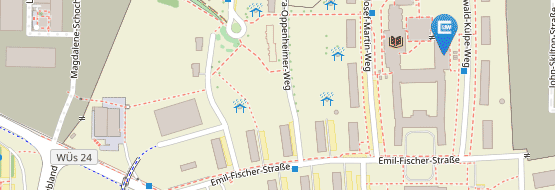Edna Carter
* 29. January 1872 in High Cliff (Wisconsin) † 14. May 1963 in Pleasant Valley (New York)
1894 Graduated from Vassar College
later Substitute principal at a high school in Wisconsin
1896 Physics assistant at Vassar College
1898 Studied at the University of Chicago
1899 Teacher at Wisconsin State Normal School, Oshkosh
1904 Began Doctorate in Würzburg
met Wilhelm Conrad Röntgen
1906 Dissertation
1912 Associate Professor of Physics at the Vassar College
1919 Vassar College Physics Chair until 1939
1920 Professorship at Vassar College
1941 Professorship at Albertus Magnus College in New Haven
1943 "Defense work" at the California Institute of Technology
Our ‘Scholar of the Month’ series continues into the New Year. As 2020 marks the 125th anniversary of Wilhelm Conrad Röntgen’s discovery of the x-ray here in Würzburg, it is fitting that our ‘Scholar of the Month’ was a physicist who worked at the Physics Institute alongside Röntgen’s colleagues and became acquainted with the man himself. Edna Carter started her doctoral research in Würzburg in 1904, using the self-same laboratory equipment as Röntgen. Part of Carter’s work focused on the character properties of the x-ray discovered only a decade before, and it was the results of her research that helped Max von Laue demonstrate the propagation of the x-ray as waves.
Early Years
Edna Carter began her academic career in Poughkeepsie, New York, at the highly regarded Vassar College. There, she studied biology under the tutelage of Professor Marcella O’Grady. Carter later switched to physics before graduating in 1894. Her first role out of college was as the substitute headmistress of a high school in Wisconsin. After getting into an argument with a minister about science in education, Carter was relieved to be able to return to Vassar College’s physics department as a laboratory assistant. The physicist later spent a year at the University of Chicago, after which she return to the field of education at Wisconsin State Normal School in Oshkosh, Wisconsin.
Time in Germany
Carter’s aforementioned mentor, Marcella O’Grady, had since taken a leave of absence from Vassar in order to work in the research laboratory of Theodor Boveri, whom she later married. During O’Grady’s time at Würzburg, she recruited several American scientists, one of which was Edna Carter, who took advantage of the opportunity to get her doctorate.
Before she moved to Würzburg in 1904, Carter spent time in England meeting several renowned scientists including Lord Kelvin, Lord Rayleigh, and Sir Oliver Lodge. Carter also made a point to meet fellow physicists once in Würzburg which is how she came to know Wilhelm Conrad Röntgen. Carter was able to use much of his laboratory equipment while working on her doctoral research under the supervision of Röntgen’s close colleague, Wilhelm Wien.
Carter would later recall her time in Würzburg both inside and outside the university grounds quite fondly, with treasured memories from engaging collegial discussions to raft trips down the Main River. The only woman in her laboratory, Carter spoke of being accepted as ‘one of the group’ when it came to her male colleagues. During a return visit in 1911, she met noted scientist Max von Laue. Carter would remain in close contact with von Laue along with Wilhelm Wien for the rest of her life.
Though Carter’s primary interest was in x-rays, it was not her sole interest - a point to which her several published articles on astrophysics attest. Yet her greatest contributions came from her work on the ‘Röntgen rays’; Carter’s findings set some critical groundwork for her close friend and colleague Max von Laue’s discovery, for which he would earn the 1914 Nobel Prize in Physics.
Return Stateside
After completing her doctorate at Würzburg in 1906, Edna Carter moved back to the United States and began working at her alma mater Vassar College. She was appointed associate professor in 1912 and received tenure as a full professor in 1920. A year prior, in 1919, Carter became chair of the Vassar College physics department, a position which she held until 1939. Leaving Vassar in 1941, Carter went on to found the Department of Physics at Albertus Magnus College in New Haven, serving as a professor for two years. From 1943 to 1944, Edna Carter worked at the California Institute of Technology.

Recommended Readings:
Vassar College Digital Library - Carter, Edna, 1872-1963 -- Memorial Minute.
https://digitallibrary.vassar.edu/islandora/object/vassar%3A31873#page/1/mode/1up
Vassar Miscellany News, Volume XXXXV, Number 9, 16 November 1960.
https://newspaperarchives.vassar.edu/cgi-bin/vassar?a=d&d=miscellany19601116-01.2.15


